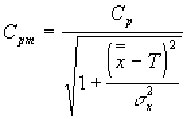Tools
Concepts
Interpretation & Calculations
Histograms, Process Capability
Applications
Key Success Factors for the Implementation of SPC
How to Study Process Capability
SPC to Improve Quality, Reduce Cost
Use Of SPC To Detect Process Manipulation
Statistical analysis of process capability data
An excerpt from The Handbook for Quality Management (2013, McGraw-Hill) by Paul Keller and Thomas Pyzdek
Control chart method: attributes data
1. Collect samples from 25 or more subgroups of consecutively produced units. Follow the guidelines presented in Part 1 of the Process Capability Series, How to Perform a Process Capability Study
2. Plot the results on the appropriate control chart (e.g., c chart). If all groups are in statistical control, go to the step #3. Otherwise, identify the special cause of variation and take action to eliminate it. Note that a special cause might be beneficial. Beneficial activities can be "eliminated" as special causes by doing them all of the time. A special cause is "special" only because it comes and goes, not because its impact is either good or bad.
3. Using the control limits from the previous step (called operation control limits), put the control chart to use for a period of time. Once you are satisfied that sufficient time has passed for most special causes to have been identified and eliminated, as verified by the control charts, go to the step #4.
4. The process capability is estimated as the control chart centerline. The centerline on attribute charts is the long-term expected quality level of the process, e.g., the average proportion defective. This is the level created by the common causes of variation.
If the process capability does not meet management requirements, take immediate action to modify the process for the better. "Problem solving" (e.g., studying each defective) will not help, and it may result in tampering. Whether it meets requirements or not, always be on the lookout for possible process improvements. The control charts will provide verification of improvement.
Control chart method: variables data
1. Collect samples from 25 or more subgroups of consecutively produced units, following the 10-step plan described in Part 1 of the Process Capability Series,How to Perform a Process Capability Study
2. Plot the results on the appropriate control chart (e.g., Xbar and R chart). If all groups are in statistical control, go to the step #3. Otherwise, identify the special cause of variation and take action to eliminate it.
3. Using the control limits from the previous step (called operation control limits), put the control chart to use for a period of time. Once you are satisfied that sufficient time has passed for most special causes to have been identified and eliminated, as verified by the control charts, estimate process capability as described below.
4. The process capability is estimated from the process average and (process) standard deviation, where the standard deviation is computed based on the average range or average standard deviation. When statistical control has been achieved, the capability is the level created by the common causes of process variation. The formulas for estimating the process standard deviation are:
R chart method to estimate process sigma:

S chart method to estimate process sigma:

The values d2 and c4 are constants from Table 10 in the appendix. (See Control Chart Constants)
Process capability indexes
Only now can the process be compared to engineering requirements. One way of doing this is by calculating Capability Indexes. Here are several popular capability indexes (for normal distributions) and their interpretation.


ZMIN = Minimum{ZL, ZU}
See also:
Interpreting Process Capability
Process Capability for Non-Normal Data Cp, Cpk
Minimum Number of Subgroups for Capability Analysis
Learn more about the SPC principles and tools for process improvement in Statistical Process Control Demystified (2011, McGraw-Hill) by Paul Keller, in his online SPC Concepts short course (only $39), or his online SPC certification course ($350) or online Green Belt certification course ($499).








